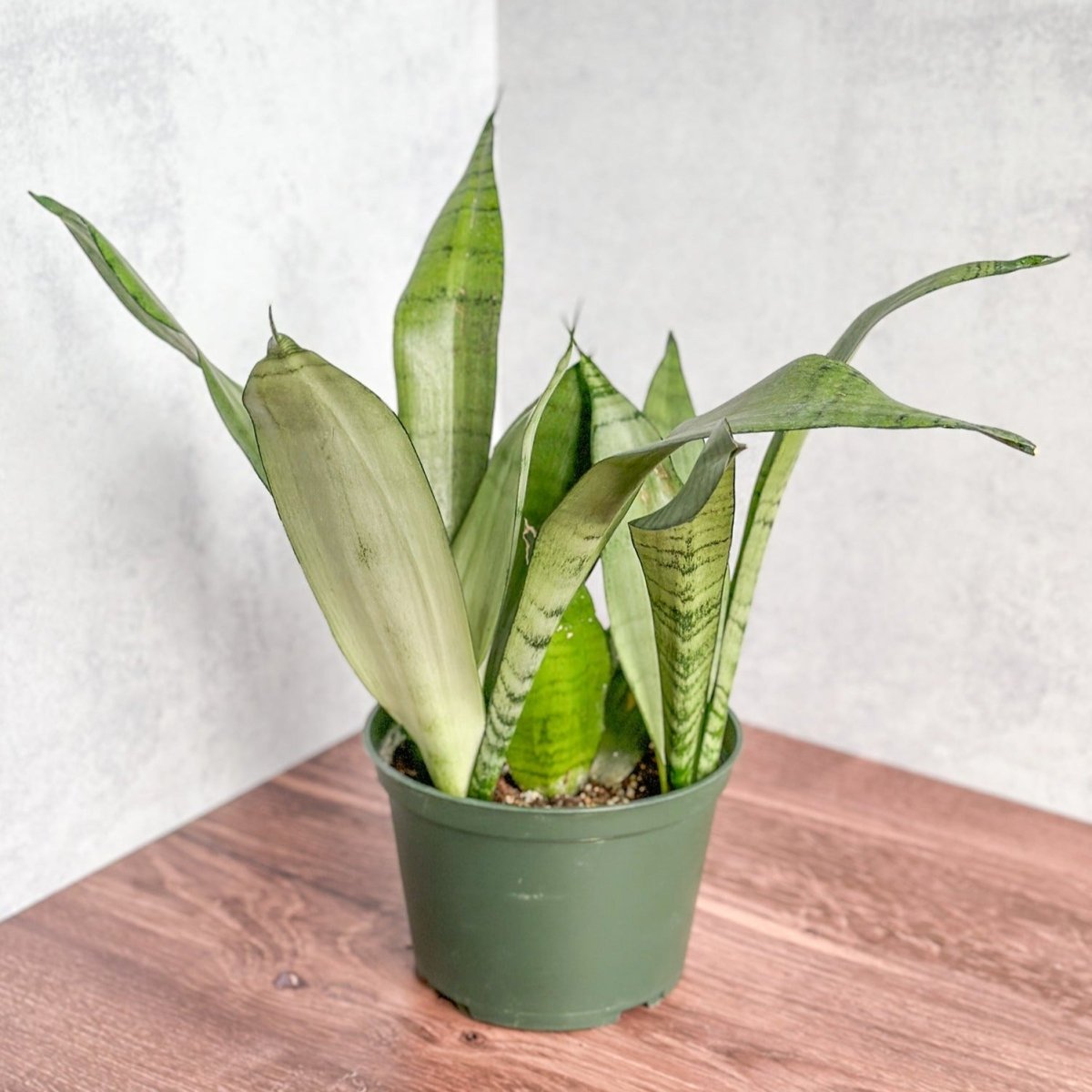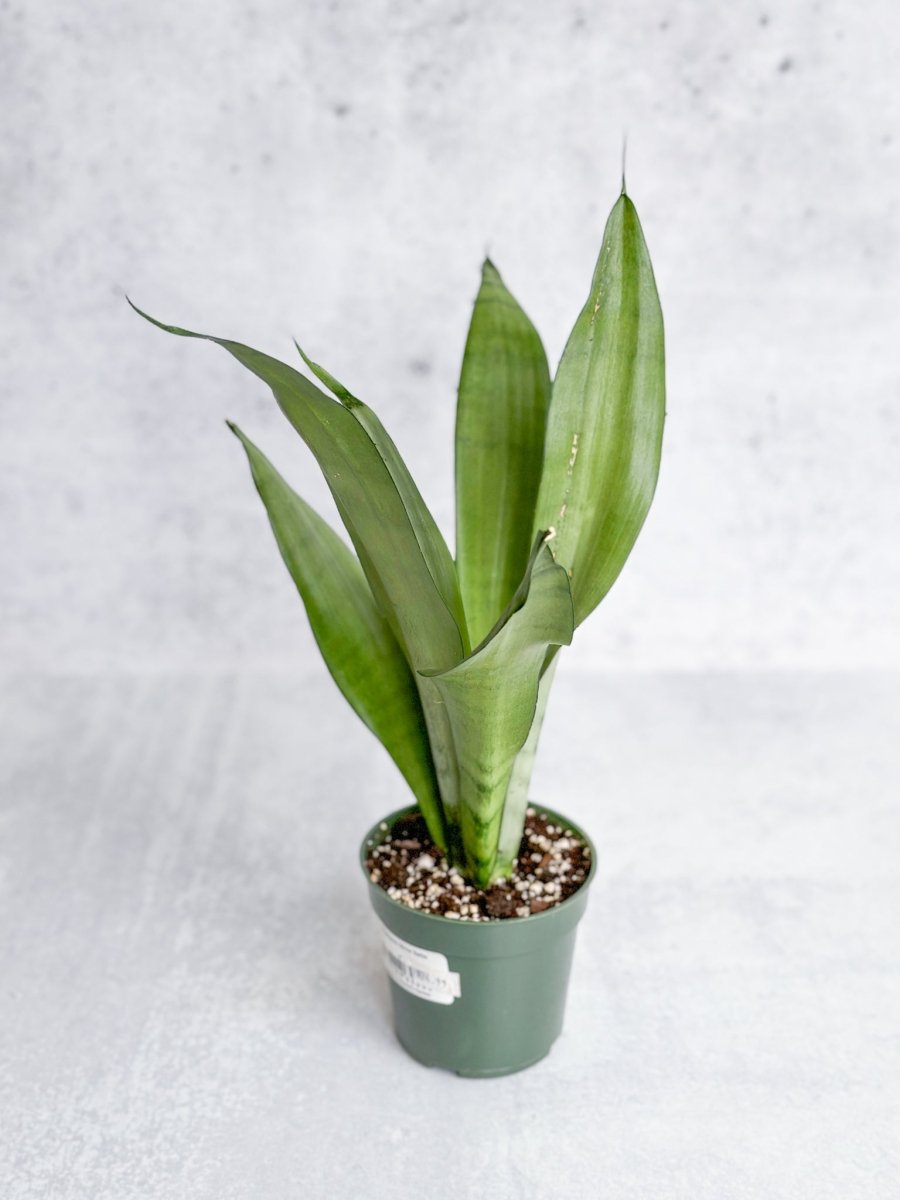Sansevieria trifasciata 'Moonshine'
Sansevieria trifasciata 'Moonshine' - 6" Nursery Pot is backordered and will ship as soon as it is back in stock.
Couldn't load pickup availability
Description
Description
Sansevieria 'Moonshine' – Elegant, Easy, and Effortlessly Modern
With its silvery-green, upright leaves and sculptural form, Sansevieria trifasciata 'Moonshine' brings a sophisticated, modern aesthetic to any space. Its clean lines and cool tones are ideal for minimalist and contemporary interiors, while its near-indestructible nature makes it perfect for beginners or low-maintenance plant lovers.
Also known as the Moonshine Snake Plant, this cultivar is not only a visual standout—it's a functional one too. Like other Sansevierias, it helps improve indoor air quality by filtering out common toxins, making it a smart and stylish addition to your home or office.
Plant Profile
Botanical Name: Sansevieria trifasciata 'Moonshine'
Common Names: Moonshine Snake Plant, Moonshine Sansevieria
Family: Asparagaceae
Native Range: West Africa
Growth Habit: Upright, slow-growing; can reach 1.5–2 feet indoors
Toxicity: Toxic to pets and humans if ingested (mild to moderate)
Care Guide
- Light: Best in bright, indirect light but adapts to low-light areas; leaves may darken in low light
- Water: Drought-tolerant—allow soil to dry out completely between waterings
- Humidity: Average indoor humidity is fine
- Temperature: 55–85°F; avoid cold drafts
- Feeding: Fertilize with a balanced houseplant fertilizer 1–2x per year in spring and summer
- Pruning: Remove damaged or dried-out leaves at the base
- Propagation: Division or leaf cuttings
- Pests: Rare; occasionally check for mealybugs or spider mites
Fun Fact: It Glows
Moonshine’s smooth, matte silver leaves almost seem to glow under low light or moonlight, giving it a serene, ethereal vibe that sets it apart from typical green foliage.
History & Lore
Native to Africa, Sansevierias were historically used for making strong fibers, and in some cultures, they were believed to ward off bad energy. The 'Moonshine' cultivar is a modern favorite due to its unique coloring and easy-going nature.
Want expert care tips?
Visit our Snake Plant Care Guide to help your Moonshine Sansevieria thrive all year round.
Keep Your Plants Cozy with Heat Packs
Frequently Asked Questions
Shipping
How do you ship your plants?
How do you ship your plants?
We carefully package each plant with love by hand right from our shop in Brooklyn. Extra steps are taken to ensure that every leaf arrives in pristine shape by using polyfill and encapsulating the plant in a protective paper sleeve. The soil is also hydrated before shipping so that the plant has plenty of water for it's travel to your doorstep. We offer several shipping speeds, so please choose the one that you feel comfortable with depending on your location.
Will my plant look like the one on the website?
Will my plant look like the one on the website?
Awesome question, we're glad you asked. Given the nature of our plant shop, we're constantly moving plants in and out of the shop, making it difficult and borderline impossible to keep an exact picture of each plant. In addition to the constantly rotating crop, we often grow in batches of 6, 12, or sometimes more! With this quantity we are unable to take a photo of each and every plant. The photos that we attach to each product listing is going to be of a plant that represents the average size and fullness of that set of plants. Some may be slightly larger or smaller, but in general, similar.
Do you include heat packs with your plants?
Do you include heat packs with your plants?
We offer Heat Packs for sale separately from the plants in 40, 60 and 72 hour increments. Please add a heat pack or two to your order if you live in an area where your order may be affected during transit by cold temperatures. We are not responsible for orders that are placed and damage is incurred to the plant if a heat pack is not purchased.
Which heat pack should I choose?
Which heat pack should I choose?
Heat packs come in three different increments, so please choose the appropriate hour increment depending on the speed of shipping that you choose during checkout. For example, if you choose a cheaper shipping option that will take longer, please select the 72 hour heat pack. If you've chosen a shorter method of shipping, the 40 or 60 hour increment would work! We like to encourage our customers to always get more than you need, just to be on the safe side!
How long will it take to receive my order?
How long will it take to receive my order?
Standard shipping normally takes 3-5 days. Next day shipping is available on all domestic orders (for an additional charge). International shipping times depend on the products and destination (estimated at checkout).
Do you offer express shipping?
Do you offer express shipping?
All orders are shipped 5-8 business days from the date it is placed. Please note that as a small plant shop, we do everything in our power to get orders out as fast as we can in the order that they come in. If you have circumstances that require expedited fulfillment, please connect with you and we can potentially offer options.
What countries do you ship to?
What countries do you ship to?
We ship our selection of rare, healthy, and unique houseplants all across the United States including California. At this time, due to customs and agricultural limitations, we are unable to ship plants internationally from the United States.
Returns and Refunds
How do I return a product?
How do I return a product?
Items must be returned within 30 days after receiving your order. Items must be returned in the same condition in which they were received, be unworn/unused, have any tags still attached, and include all the original packaging.
How long will it take to receive my refund?
How long will it take to receive my refund?
Refunds are processed within 7 days from when we receive the item(s).
What should I do if my plant arrives in poor shape?
What should I do if my plant arrives in poor shape?
In the extremely unlikely event that your plant arrives in less than perfect condition, you're covered by our 15-day plant health guarantee. Simply snap a photo of your plant and send it over to us. We'll happily take a peek and offer suggestions on how to perk it back up, offer a store credit, or send a replacement. We like to make it as easy as possible!
Can I return or exchange a plant?
Can I return or exchange a plant?
At this time, we do not accept returns on plants. In extreme circumstances where a return of a plant is necessary, the customer is responsible for the return shipping and a refund will only be issued if the plant arrives back to us in living condition.











